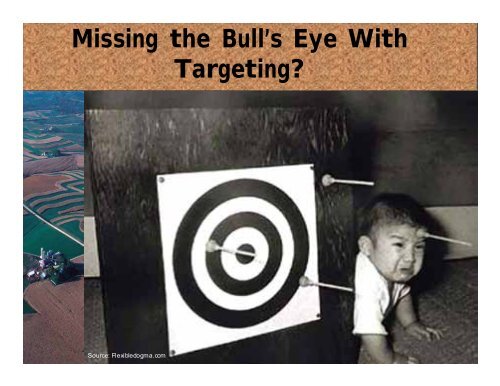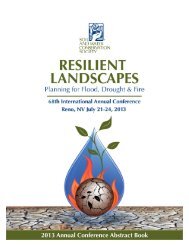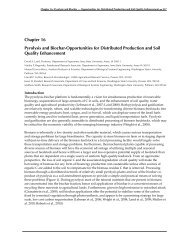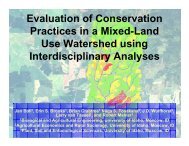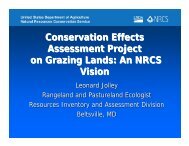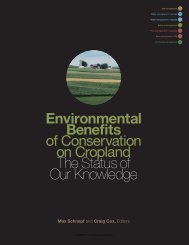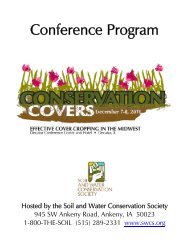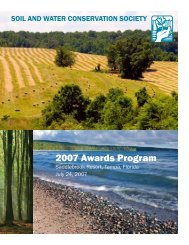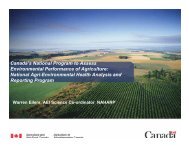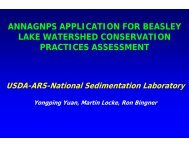Bentrup, Gary - Soil and Water Conservation Society
Bentrup, Gary - Soil and Water Conservation Society
Bentrup, Gary - Soil and Water Conservation Society
You also want an ePaper? Increase the reach of your titles
YUMPU automatically turns print PDFs into web optimized ePapers that Google loves.
Missing the Bull’s Eye With<br />
Targeting?<br />
Source: Flexibledogma.com
Purpose of Targeting<br />
• Effective use of limited resources<br />
to focus preservation, conservation<br />
<strong>and</strong> other management alternatives<br />
to improve environmental quality<br />
Biophysical Foundation
Moving Data into Action<br />
ACCEPTANCE<br />
ADOPTION<br />
CULTURAL SUSTAINABILITY
Challenges
Challenges<br />
Urban/suburban l<strong>and</strong>s contribute<br />
more nitrogen (30 lb/ac/yr) than<br />
agricultural l<strong>and</strong>s (17 lb/ac/yr).<br />
Chesapeake Bay Foundation
Principles for Targeting Tools<br />
1. What, Where, How<br />
2. Biophysical, Economic, <strong>and</strong> Social<br />
3. User Participation<br />
4. Multiple Scales <strong>and</strong> L<strong>and</strong> Uses<br />
5. Loosely Coupled
1.What, Where, How<br />
Targeting Tools<br />
versus<br />
Research Tools
Research Tools<br />
Why?<br />
Source: www.icsu-scope.org/
Targeting Tools<br />
What, Where, <strong>and</strong> How?
2. Biophysical, Economic, Social
2. Biophysical, Economic, Social
2. Biophysical, Economic, Social
2. Biophysical, Economic, Social
3. User Participation
Tool Adoption Factors<br />
• Based on familiar data, procedures<br />
equations, etc.<br />
• Readily available data<br />
• Avoid the “black box”<br />
• Decision-support not decision-making
4. Multiple Scales-L<strong>and</strong> Uses<br />
Economic stability<br />
Stable banks<br />
<strong>Water</strong> quality<br />
Site<br />
Community<br />
<strong>Water</strong>shed<br />
Wildlife population<br />
Region
Surface Runoff Sediment<br />
Trapping Efficiency<br />
Percent Trapping Efficiency<br />
0-25.00<br />
0 125 250 500<br />
Kilometers<br />
25.01-50.00<br />
50.01-75.00<br />
75.01-100
Surface Runoff Sediment<br />
Trapping Efficiency<br />
Percent Trapping Efficiency<br />
75.01-100<br />
50.01-75.00<br />
25.01 - 50.00<br />
0-25.00<br />
<strong>Water</strong> Bodies<br />
<strong>Soil</strong>s Not Meeting Criteria<br />
0 50 100 200 Kilomet ers
Surface Runoff Sediment<br />
Trapping Efficiency<br />
Percent Trapping Efficiency<br />
75.01 - 100.00<br />
50.01 - 75.00<br />
25.01 - 50.00<br />
0 - 25.00<br />
<strong>Soil</strong>s not meeting criteria<br />
<strong>Water</strong> Bodies<br />
0 0. 5 1 2<br />
Kilometers
4. Multiple Scales-L<strong>and</strong> Uses<br />
Over 70% of the l<strong>and</strong> area<br />
is in agricultural production
5. Loosely Coupled<br />
Planning as a linear process<br />
1. 2. 3. 4. 5. 6.
5. Loosely Coupled<br />
Planning as an iterative process<br />
1. 2. 3. 4. 5. 6.
<strong>Conservation</strong> Buffer<br />
Planning Project
Soldier Creek<br />
<strong>Water</strong>shed<br />
Grassl<strong>and</strong>s/Herbaceous<br />
Pasture/Hay<br />
Row Crops<br />
Small Grain<br />
Fal low<br />
Low Intensity Residential<br />
High Intensity Residential<br />
Commercial/Industrial/Tran<br />
Deciduous Forest<br />
TOPEKA
Sediment Trapping<br />
Efficiency<br />
Percent Trapping Efficiency<br />
0 - 2 5 H<br />
2 5 -5 0 M H<br />
5 0 -7 5 M L<br />
7 5 -1 00 L<br />
N o t F a rm a b le<br />
W a te r<br />
5 0<br />
10<br />
miles
Decorative Willow Market Values<br />
Net Value - 1,000’<br />
Scarlet Curls Willow $3580<br />
Streamco Willow $1580<br />
French Pussy Willow $ 450<br />
Curly Willow $ 430<br />
(4-5’ foot plant spacing)
Decorative Willows<br />
Decorative Willow Suitability<br />
Highly Favor able<br />
Favorable<br />
5 0<br />
10<br />
miles
Wildlife Habitat & Movement<br />
Riparian Connectivity
Riparian Connectivity<br />
Rodger Barbour<br />
Mont St-Hilaire Nature Center<br />
#@%&*$@!!<br />
0.18 km<br />
Greg Sievert<br />
• 0.1 ha patches<br />
• Disperses 0.16 km<br />
<strong>Bentrup</strong> <strong>and</strong> Kellerman 2004
Riparian<br />
Connectivity<br />
Riparian Connectivity<br />
Ri parian Are as<br />
Co nn ectivity Zones<br />
Cr itical Gaps<br />
5 0<br />
10<br />
miles
Multiple<br />
Objectives<br />
Locations where plantings can:<br />
1. Protect <strong>and</strong> improve water quality<br />
2. Provide an alternative ag. product<br />
3. Restore riparian corridors for wildlife<br />
5 0<br />
10<br />
miles
Planning <strong>and</strong> Design Principles
<strong>Water</strong> Quality
Species & Habitat
Economic Opportunities
Visual Simulations
Benefits of 2-D Simulations<br />
• Promote better underst<strong>and</strong>ing<br />
• Increase involvement in planning<br />
• Create shared vision<br />
• Increase ownership<br />
• Increase adoption
Visual Simulation Starter Kit
Suite of Tools
Object Libraries
Visual Simulations
Assembling the Pieces<br />
Biological<br />
Considerations<br />
Social<br />
Considerations<br />
Questions?<br />
Economic<br />
Considerations<br />
Physical<br />
Considerations


